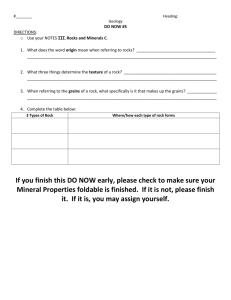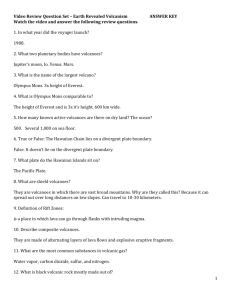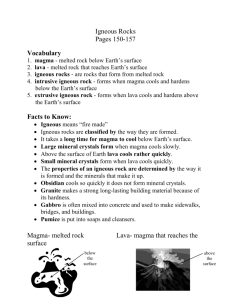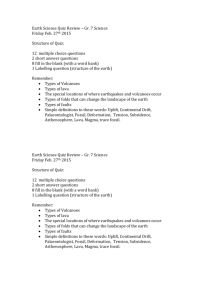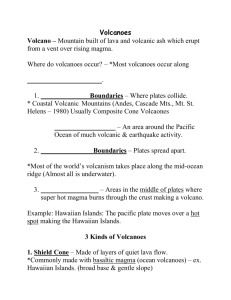Blakeley Jones September 9, 2009 Review 2 – Igneous Chapter 4
advertisement
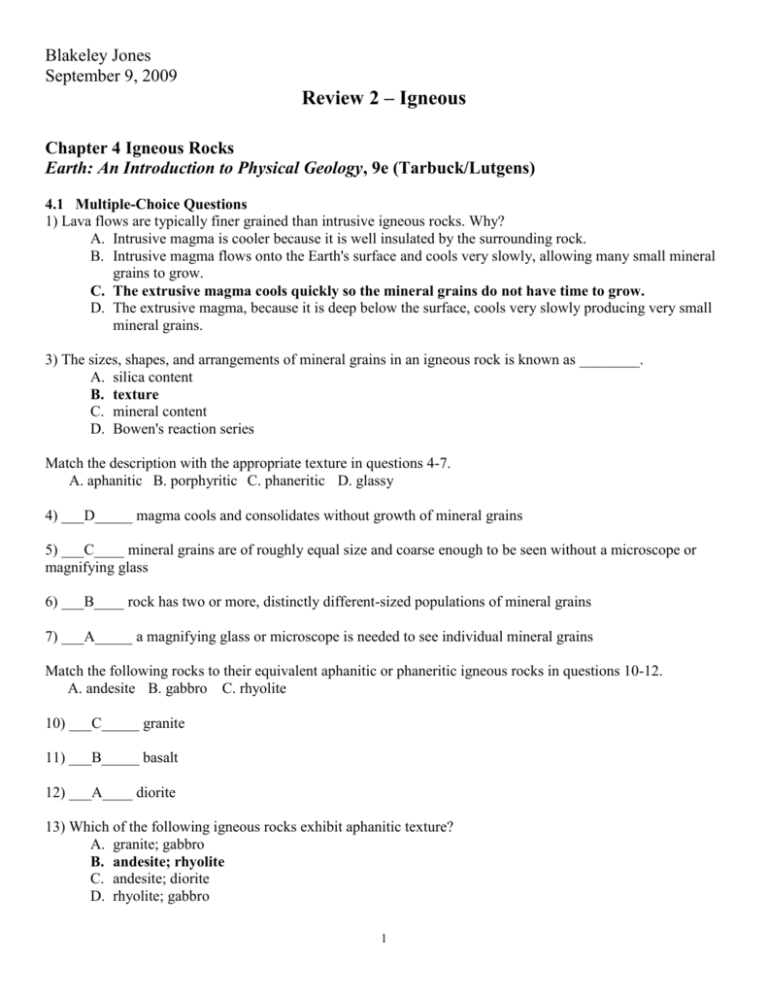
Blakeley Jones September 9, 2009 Review 2 – Igneous Chapter 4 Igneous Rocks Earth: An Introduction to Physical Geology, 9e (Tarbuck/Lutgens) 4.1 Multiple-Choice Questions 1) Lava flows are typically finer grained than intrusive igneous rocks. Why? A. Intrusive magma is cooler because it is well insulated by the surrounding rock. B. Intrusive magma flows onto the Earth's surface and cools very slowly, allowing many small mineral grains to grow. C. The extrusive magma cools quickly so the mineral grains do not have time to grow. D. The extrusive magma, because it is deep below the surface, cools very slowly producing very small mineral grains. 3) The sizes, shapes, and arrangements of mineral grains in an igneous rock is known as ________. A. silica content B. texture C. mineral content D. Bowen's reaction series Match the description with the appropriate texture in questions 4-7. A. aphanitic B. porphyritic C. phaneritic D. glassy 4) ___D_____ magma cools and consolidates without growth of mineral grains 5) ___C____ mineral grains are of roughly equal size and coarse enough to be seen without a microscope or magnifying glass 6) ___B____ rock has two or more, distinctly different-sized populations of mineral grains 7) ___A_____ a magnifying glass or microscope is needed to see individual mineral grains Match the following rocks to their equivalent aphanitic or phaneritic igneous rocks in questions 10-12. A. andesite B. gabbro C. rhyolite 10) ___C_____ granite 11) ___B_____ basalt 12) ___A____ diorite 13) Which of the following igneous rocks exhibit aphanitic texture? A. granite; gabbro B. andesite; rhyolite C. andesite; diorite D. rhyolite; gabbro 1 14) In a porphyritic volcanic rock, which mineral grains are the last to crystallize? A. phenocrysts B. vesicles C. pegmatites D. matrix or groundmass 17) ________ is a volcanic rock that is extremely vesicular and glassy. A. Obsidian B. Pegmatite C. Tuff D. Pumice 19) Which of the following minerals crystallize early in Bowen's reaction series? A. biotite B. quartz C. olivine D. muscovite 22) ________ is characterized by very coarse mineral grains? A. Obsidian B. Pumice C. Pegmatite D. Granite 24) A (an) ________ texture represents a single, long period of cooling and crystallization. A. glassy B. pyroclastic C. aphanitic D. phaneritic 27) Which of the following best describes an aphanitic texture? A. The rock is crystalline; mineral grains are too small to be visible without a magnifying lens or microscope. B. The mineral grains have glassy textures. C. The rock consists of broken, volcanic-rock and mineral fragments. D. The rock is crystalline; mineral grains are of distinctly different sizes. 34) The last minerals to crystallize on Bowen's Reaction Series result in igneous rocks with a ________ composition. A. felsic B. intermediate C. mafic D. ultramafic 35) Changing the composition of magma by incorporating surrounding host rock is known as ________. A. magma mixing B. partial melting C. differentiation D. assimilation 36) All of the following are factors that affect the generation of magma except for ________. 2 A. B. C. D. heat pressure crystal size volatiles 4.3 True/False Questions 1) T or F: Bowen's reaction series predicts the sizes of the different mineral grains that grow from crystallizing magmas. TRUE 2) T or F: In an igneous rock with a phaneritic texture, the mineral grains are visible to the unaided eye. TRUE 6) T or F: Basalt is the aphanitic or fine-grained equivalent of gabbro. TRUE 9) T or F: Olivine is an important mineral in peridotites and other ultramafic rocks. TRUE 11) T or F: Glassy igneous rocks form when magma cools too fast for mineral grains to grow. TRUE 3 Chapter 5 Volcanoes and Other Igneous Activity Earth: An Introduction to Physical Geology, 9e (Tarbuck/Lutgens) 5.1 Multiple-Choice Questions 1) In 1980, ________ was the first Cascade Range volcano to erupt since Mt. Lassen, California, in 1915-16. A. Mt. Rainier B. Mt. Shasta C. Kilauea D. Mt. St. Helens 2) Which type of basaltic lava flow has a fairly smooth, unfragmented, ropy surface? A. aa B. pegmatitic C. pahoehoe D. scoria 3) ________ is a major dissolved volatile constituent in both magmas and volcanic gases? A. Water B. Carbon monoxide C. Hydrogen chloride D. Methane 7) ________ magma is the most abundant type of erupted at oceanic spreading centers. A. Basaltic B. Granitic C. Andesitic D. Pegmatitic 9) The ________ ocean basin is rimmed by the most subduction zones. A. Atlantic B. Indian C. Pacific D. Arctic 11) Which of the following is associated with deep mantle hot spots? A. Vesuvius and the other volcanoes of Italy B. the volcanoes of Hawaii and the Quaternary activity in Yellowstone National Park C. the very young cinder cones scattered across the southwestern United States D. Mt. St. Helens and other volcanoes of the Cascade Mountains 16) ________ are usually the most abundant gases emitted during basaltic volcanism. A. Chlorine and sodium B. Neon and ammonia C. Oxygen and nitrogen D. Water and carbon dioxide For questions 17-21, please choose from one of the following answers. A. shield volcanoes B. composite/stratovolcanoes C. cinder cones 17) ___A_____ massive, gently sloping volcanoes built of successive, basaltic lava flows 4 18) ___C_____ large, fairly steep-sided cones composed of lavas and pyroclastic layers 19) ___C____ small basaltic cones built during one, short, eruptive episode 20) ___B_____ the volcanoes of southwestern Alaska and the Aleutian Islands 21) ____A____ the big volcanoes of Hawaii 22) Which statement about the May, 1980, eruption of Mount St. Helens is false? A. During the eruptive period, the mountain peak was substantially built up by new lava flows and pyroclastic debris. B. Plumes of ash rose high into the atmosphere during the major eruptive events. C. Mudflows accompanied the major eruptive events. D. The most powerful explosive event was preceded by a massive landslide. 23) ________ tend to increase the explosive potential of a magma body beneath a volcano. A. High viscosity and dissolved gas B. High viscosity; low dissolved gas content C. Low silica content, low viscosity D. Low viscosity; low dissolved gas content 24) Which type of basaltic lava flow has its surface covered with sharp-edged, angular blocks and rubble? A. scoria B. pahoehoe C. pillow lava D. aa 29) Which kind of eruptive activity is most likely to be highly explosive? A. Lava flows from a large shield volcano on an oceanic island. B. Fissure eruptions feeding lava to flood basalt accumulations. C. Eruptions of big, continental margin, composite cones or stratovolcanoes. D. Lava flows from a large cinder cone complex. 33) Mount St. Helens is ________. A. a basaltic cinder cone B. an explosive stratovolcano C. a basaltic shield volcano D. a small, welded tuff cone 36) A ________ volcano is a very large, gently sloping mound composed mainly of basaltic lava flows. A. composite B. stratospheric C. cinder cone D. shield 37) Which of the following best describes Shiprock, a famous volcanic feature in New Mexico? A. a very recently active, basaltic cinder cone B. an extinct, highly symmetrical, composite volcanic cone C. the eroded remains of a volcanic pipe and radiating dikes D. an extinct, massive, rhyolitic shield volcano 5 38) Which region has the greatest concentration of currently active volcanoes? A. the coastal plain of western Africa B. European Russia and Siberia C. the area surrounding the Red Sea D. the circum-Pacific area 39) The recent (geologically) volcanic activity in Yellowstone National Park is ________. A. related to plate subduction B. related to a divergent plate boundary C. related to a transform plate boundary D. related to intraplate, hot spot volcanism 40) The Icelandic volcanoes are related to plate tectonics because ________. A. they lie on a spreading center where two plates are converging B. they lie on a subduction zone where two plates are converging C. they lie on a spreading center where two plates are moving apart D. they lie along a subduction zone where two plates are diverging 41) Which one of the following best describes volcanism in the Cascade Range, northwestern United States? A. related to a mantle hot spot B. related to plate subduction C. related to a mid-oceanic ridge system D. related to deep, transform faults 42) Which of the following statements best describes the big Hawaiian volcanoes? A. lie directly above a transform plate boundary that cuts deeply into the mantle B. lie directly above an active subduction zone where the Pacific plate is sinking into the mantle C. lie along the crest of the East Pacific Rise, a mid-ocean ridge or spreading center D. are situated in the interior of a large, Pacific plate above a hot spot deep in the mantle 45) Which one of the following shows the correct order (left to right) of decreasing magma viscosity? A. rhyolite, andesite, basalt B. andesite, rhyolite, basalt C. basalt, rhyolite, andesite D. basalt, andesite, rhyolite 46) Why do magmas rise toward Earth's surface? A. Magmas are more viscous than solid rocks in the crust and upper mantle. B. Most magmas are richer in silica than most crustal and upper mantle rocks. C. Magmas are mainly liquid and contain dissolved fluids such as water; most are less dense than the adjacent solid rock. D. all of the above 48) A ________ is the largest, discordant body of intrusive, igneous rock. A. lopolith B. laccolith C. pluton D. batholith 49) A ___D_____ is an intrusive, igneous rock body that is tabular and concordant. 6 A. B. C. D. laccolith dike pluton sill 50) A ___C_____ is a near surface, intrusive, igneous rock body that results from local inflation of a horizontal sill. A. batholith B. dike C. laccolith D. volcanic neck 5.3 True/False Questions 3) T or F: The viscosities of magmas increase with increasing percentages of silica. FALSE 4) T or F: The eruptions of the Hawaiian volcanoes may be described as explosive in comparison to the 1980 Mount St. Helens eruption. TRUE 5) T or F: Powerful, explosive, volcanic eruptions can result in climatic cooling for millions of years following the eruption. TRUE 9) T or F: Basaltic lavas are generally hotter and more viscous than andesite lavas. TRUE 12) T or F: In general, cinder cones are much larger than shield volcanoes. FALSE 16) T or F: Basalt is the most common magma erupted along oceanic rift systems. TRUE 7
